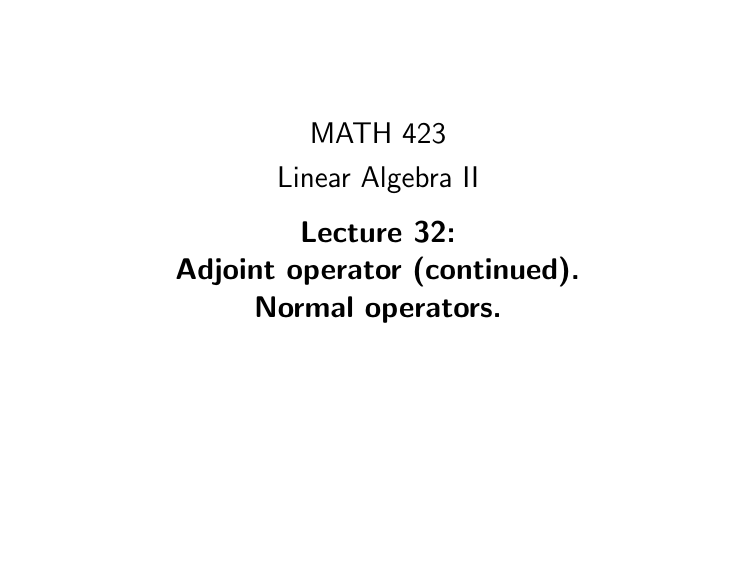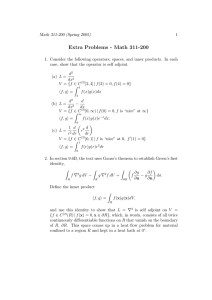MATH 423 Linear Algebra II Lecture 32: Adjoint operator (continued).
advertisement

MATH 423 Linear Algebra II Lecture 32: Adjoint operator (continued). Normal operators. Dual of an inner product space Let V be a vector space with an inner product h·, ·i. For any y ∈ V consider a function ℓy : V → F given by ℓy (x) = hx, yi for all x ∈ V . This function is linear. Theorem Let θ : V → V ′ be given by θ(v) = ℓv . Then (i) θ is linear if F = R and half-linear if F = C. (ii) θ is one-to-one, that is, v is uniquely recovered by ℓv . (iii) If V is finite-dimensional, then θ is onto, i.e., any linear functional on V is uniquely represented as ℓv for some v ∈ V . Adjoint operator Let L be a linear operator on an inner product space V . Definition. The adjoint of L is a transformation L∗ : V → V satisfying hL(x), yi = hx, L∗(y)i for all x, y ∈ V . An equivalent condition is that ℓy ◦L = ℓL∗ (y) for all y ∈ V . Notice that the adjoint of L may not exist. Theorem (i) If the adjoint operator L∗ exists, it is unique and linear. (ii) If V is finite-dimensional, then L∗ always exists. Properties of adjoint operators: • (L1 + L2 )∗ = L∗1 + L∗2 • (rL)∗ = r L∗ • (L1 ◦L2 )∗ = L∗2 ◦L∗1 • (L∗ )∗ = L • id∗V = idV Adjoint matrix Suppose A = (aij ) is an m×n matrix with complex entries. The adjoint matrix of A is an n×m matrix A∗ = (bij ) such that bij = aji . In other words, A∗ = At . Properties of adjoint matrices: • (A + B)∗ = A∗ + B ∗ • (rA)∗ = r A∗ • (AB)∗ = B ∗ A∗ • (A∗ )∗ = A • I∗ = I • (A−1 )∗ = (A∗ )−1 Theorem Let L be a linear operator on an inner product space V of finite dimension. If β is an orthonormal basis for V , then [L∗ ]β = ([L]β )∗ . Theorem Let L be a linear operator on an inner product space V of finite dimension. If β is an orthonormal basis for V , then [L∗]β = ([L]β )∗. Proof: Let β = [v1 , v2, . . . , vn ]. Let A = (aij ) be the matrix of L and B = (bij ) be the matrix of L∗ relative to this basis. By definition, aij is the i th coordinate of the vector L(vj ). Since the basis β is orthonormal, we have aij = hL(vj ), vi i. Likewise, bij = hL∗ (vj ), vi i. For any indices i , j, bij = hL∗ (vj ), vi i = hvi , L∗(vj )i = hL(vi ), vj i = aji . Thus B = A∗ . Example. V = C2 , hx, yi = x1y1 + x2y2. L(z1, z2) = (z1 − 2iz2, 3z1 + iz2). L is a linear operator. Thematrix of L relative to 1 −2i the standard basis is A = . 3 i Since the standard basis is orthonormal, the matrix 1 3 of the adjoint L∗ is A∗ = At = . 2i −i z 1 3 z1 1 Therefore L∗ = . z2 z2 2i −i Equivalently, L∗ (z1, z2) = (z1 + 3z2, 2iz1 − iz2). ∞ Example. V = C ([a, b]), hf , g i = L(f ) = f ′ . hL(f ), g i = Z x=a b f (x)g (x) dx. a b a b = f (x)g (x) Z − f ′ (x)g (x) dx Z b f (x)g ′(x) dx a = f (b)g (b) − f (a)g (a) + hf , −L(g )i. If g (a) 6= 0 or g (b) 6= 0, then there is no function h ∈ C ∞ ([a, b]) such that f (b)g (b) − f (a)g (a) = hf , hi for all f ∈ C ∞ ([a, b]). Therefore the operator L has no adjoint. Z b Example. V = (C [a, b], C), hf , g i = f (x)g (x) dx. a Z b (Lf )(x) = K (x, y )f (y ) dy , where K is a continuous a function on [a, b] × [a, b]. The operator L is called an integral operator; the function K is called the kernel of L. Z b Z b hL(f ), g i = K (x, y )f (y ) dy g (x) dx a = Z bZ a = Z a b f (y ) Z a b K (x, y )f (y )g (x) dx dy a b a K (x, y ) g (x) dx dy = hf , e L(g )i, where e L is an integral operator with the kernel e (x, y ) = K (y , x). Thus e K L is the adjoint operator of L. Normal operators Definition. A linear operator L on an inner product space V is called normal if it commutes with its adjoint. That is, if the adjoint operator L∗ exists and L◦L∗ = L∗ ◦L. There are several special classes of normal operators important for applications. The operator L is self-adjoint if L∗ = L. Equivalently, hL(x), yi = hx, L(y)i for all x, y ∈ V . The operator L is anti-selfadjoint if L∗ = −L. The operator L is unitary if L∗ = L−1. Normal matrices Definition. A square matrix A with real or complex entries is normal if AA∗ = A∗ A. Theorem Let L be a linear operator on a finite-dimensional inner product space. Suppose A is the matrix of L relative to an orthonormal basis. Then the operator L is normal if and only if the matrix A is normal. Special classes of normal operators give rise to special classes of normal matrices. A matrix A ∈ Mn,n (C) is Hermitian if A∗ = A, skew-Hermitian if A∗ = −A, and unitary if A∗ = A−1 . A square matrix B with real entries is symmetric if B t = B, skew-symmetric if B t = −B, and orthogonal if B t = B −1 .






